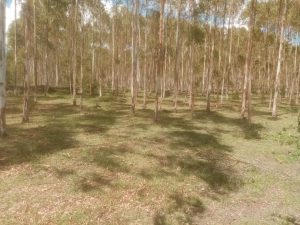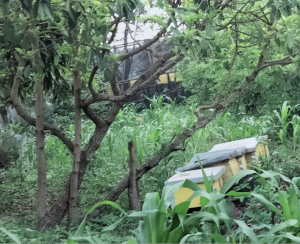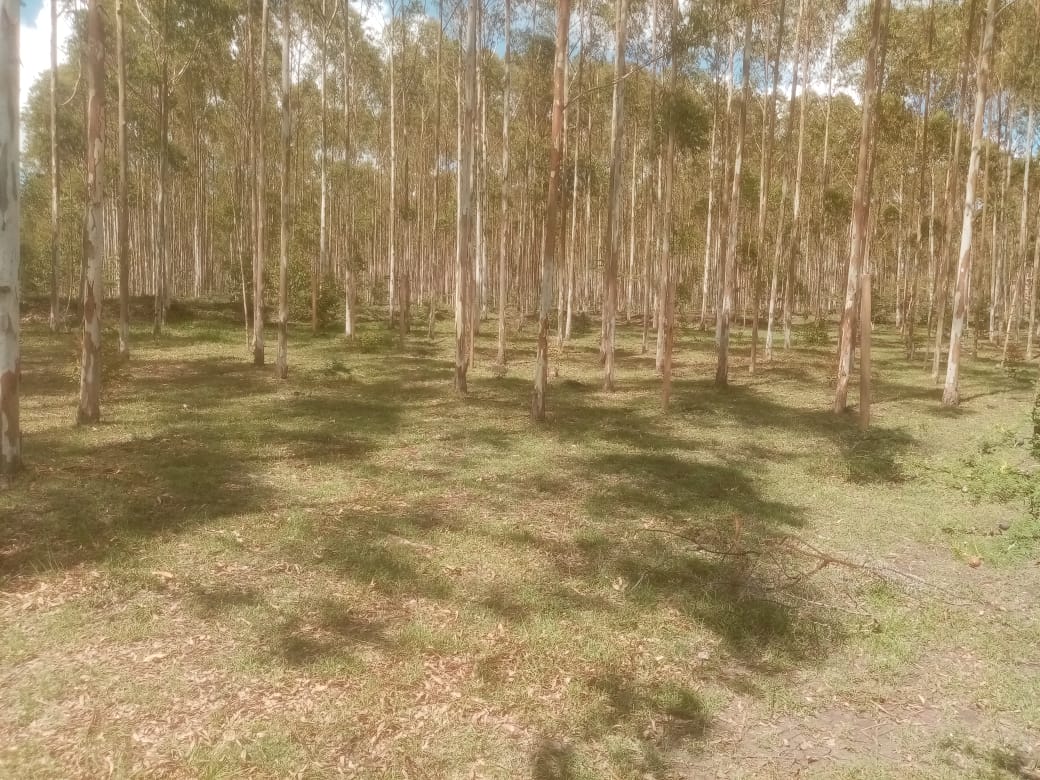
Dry, barren ground under the exotic Eucalyptus trees of a plantation in Kenya
By Najar Nyakio Munyinyi,
RC Laikipia Highlanders, Nanyuki, Kenya
Biological diversity is essential to human well-being. The more complex and diversified a trophic system is, the healthier the environment, and the higher the quality of air, soil and water. Africa has the greatest diversity of fruit and food trees on earth, with a whopping 1,200 species of fruit and food trees specific and indigenous to the African Continent. These constitute an important biological resource in both farm and forest ecosystems.
In Africa, all our animals, birds, bees, butterflies and bugs – our biological diversity – are an essential and integral function of our eco- and tropic system. As environmentalists working on forestation, we must identify and determine the tropic and food/plant web system of each zone of all our countries, and teach our communities that foreign and exotic trees cannot maintain ecological stability.
Eucalyptus is depleting Kenyan soil and water: The word “exotic” contains the same letters that form the word “toxic.” Exotic means “foreign” and “not at home”. When you place an entity outside its environment, it becomes toxic.
Because of plantation of trees foreign to Kenya, we are experiencing an extreme disruption in tropic levels. The planting of thousands upon thousands of exotic trees in our water catchment areas, our mountain areas, and our plains has caused a massive imbalance of the entire ecosystem. The result is that we continue to lose thousands of living creatures in our forests and plains daily.
The Eucalyptus tree is a species notorious for contributing to droughts in water-scarce places. In Kenya this tree nicknamed “Munywi Maai” (drinker of water) has caused the drying up of hundreds of river beds where it has been planted. The millions of Eucalyptus trees planted in Kenya have resulted in a dramatic loss of biological life and depleted our soils, weakening their resistance to disease and their capacity to recover.
Kenyan environmental experts are deeply concerned about these impacts. But in the “conservation” of our lands and within Agro-Forestry we have fallen very short in teaching and raising public awareness regarding Kenya’s current environmental crisis. Our unique and rich biodiversity has been largely ignored by those who push for the mono-culture of millions of exotic trees for a timber market.
As a result, our rivers are unstable, our soils dry and over-chemicalized through the use of pesticides, insecticides and soil germicides. Desertification encroaches from the Equator line, our arable land has decreased, soil yield has fallen, and our wildlife is dying. This loss of biodiversity has a profound impact of both natural and managed eco-systems to deliver ecological services human societies depend on, like food crops.

Crops and pollinators flourishing under indigenous trees on a family farm just 500 meters away from the Eucalyptus plantation. Photos by environmental educator and ESRAG member Mercy Wambui
To restore our soil, water, and air, we need to move away from exotic mono-culture forest plantations – if possible completely banning the practice – and progress towards the cultivation of diverse tree species. This will influence our whole ecosystem functions, including productivity and how Nature naturally maintains ecosystem stability.
So which trees can we plant then? In Greater East Africa there are 800 fruit and food trees indigenous to the region, which includes the Arabian continental shelf comprised of Saudi Arabia, Yemen, Somali, Ethiopia, Sudan, Uganda, Democratic Republic of Congo, Rwanda, Burundi, Tanzania, and Kenya.
Sadly, within our African educational systems we are taught about just a tiny fraction of these fruit, food and spice trees, focusing just on the cash crops destined for a Western market and for a Western palette – for example, the cocoa tree in West Africa. The true numbers of indigenous fruit and food trees in Africa are not taught.
It is wretched that we in Africa often unknowingly give away the ownership of our trees by stating that they are originally from other continents like Asia, when the opposite is often quite true – many spice, fruit and fruit trees originate in Africa.
Greater biological diversity in our ecosystems, species, and individuals leads to greater eco-stability. Species with high genetic diversity and many populations that are adapted to a wide variety of conditions are more likely to be able to weather disturbances, disease, and climate change. Greater biodiversity also enriches us with more varieties of foods and medicines. This was our Kenyan heritage.
Environmentalist Najar Nyakio Munyinyi: has completed the Positive Peace Course and is a member of the Institute for Economics and Peace (IEP Peace Academy); BA in Design UON 1987, Certified Biophilic Design Practitioner, Permaculturalist, Permaculture Gardens Designer; Locally Certified for East Africa as a holder of Knowledge of Indigenous Herbs, Shrubs and Plants for healing purposes, African Wombman’s Rights Activist. She is the author of “Indigenous Fruit & Food Trees of Kenya,” and the Healing Through Greening Curriculum. She is partnering with fellow Rotarian and educator Mercy Wambui (Lavington Eco Rotary Club) to share this curriculum with Kenyan students.

